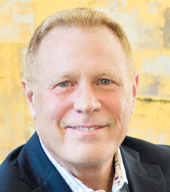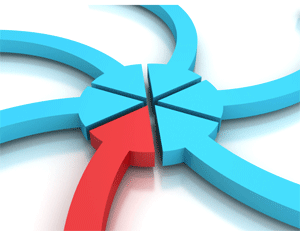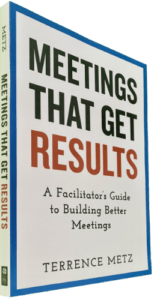Not all situations are covered by cookbook agendas or avail a methodologist to help. The facilitator must develop their approach another way. Therefore, use the Single Question Approach to develop new questions that lead to a meeting method complete with a detailed agenda.
The Single Question Approach breaks down the big question that analyzes the primary problem by breaking it into detailed supporting questions. Focused questions provide groups with traction and are much easier to answer.
Method for the Single Question Approach
The Questions
What is the single question, the answer to which the group needs to know to accomplish its purpose?
Example: A workshop to design a newsletter could begin with the single (and broad) question, “What is the content and format of this newsletter?”
Sub-Questions
What sub-questions must be answered before we can answer the single question we just formulated? While preparing, talk to participants and find out what questions they suggest we answer during the meeting. Test your questions prior to the meeting for clarity, precision, and completeness.
Example: Our newsletter workshop question can be answered when the following sub-questions are answered.
- Who is the newsletter audience?
- What is the purpose of the newsletter?
- What are their interests?
- Why would they read a newsletter?
- What do they already know?
- What do they want to know?
- Which media would they prefer?
Sequencing
Sequence them in an appropriate order—which needs to be answered first, second, and so on. Sequencing creates topical flow—facilitators lead with coherent agenda steps, not a laundry list of questions. The order is based on which answers help in answering subsequent questions.
Example: For our newsletter, the questions might be answered in the following sequence.
- What is the purpose of the newsletter?
- Who is the newsletter audience?
- Why would they read a newsletter?
- What are their interests?
- Do we know what they want to know?
- What do they already know?
- Which media would they prefer?
Organizing
Next group the questions. We could just leave them as is and step through the questions in this order, but it doesn’t clearly provide us with our deliverable. Participants think better when we categorize information to create natural breaks. Group the questions into a single, definable product at the end of each set of questions—or question.
Example: In our newsletter example, we might have four key categories; Newsletter Purpose, Audience, Content, and Media.
- Question 1 defines the Newsletter’s Purpose.
- Questions 2 and 3 define the Audience.
- Questions 4, 5, and 6 define the Content.
- Question 7 defines the Media.
Agenda
What are the best descriptors and sequence of the categories?
Example: Our newsletter workshop simple agenda might be . . .
- Introduction
- Purpose of the newsletter
- Audience
- Content
- Media
- Review and Wrap up
Comments
- Advantages—Good if under time pressure and you need a quick agenda. Forces a decision. Include within other agendas.
- Disadvantages—Very difficult in conflict-ridden or very complex situations.
______
Don’t ruin your career by hosting bad meetings. Sign up for a workshop or send this to someone who should. MGRUSH workshops focus on meeting design and practice. Each person practices tools, methods, and activities daily during the week. Therefore, while some call this immersion, we call it the road to building high-value facilitation skills.
Our workshops also provide a superb way to earn up to 40 SEUs from the Scrum Alliance, 40 CDUs from IIBA, 40 Continuous Learning Points (CLPs) based on Federal Acquisition Certification Continuous Professional Learning Requirements using Training and Education activities, 40 Professional Development Units (PDUs) from SAVE International, as well as 4.0 CEUs for other professions. (See workshop and Reference Manual descriptions for details.)
Want a free 10-minute break timer? Sign up for our once-monthly newsletter HERE and receive a free timer along with four other of our favorite facilitation tools.

Terrence Metz, president of MG RUSH Facilitation Training, was just 22-years-old and working as a Sales Engineer at Honeywell when he recognized a widespread problem—most meetings were ineffective and poorly led, wasting both time and company resources. However, he also observed meetings that worked. What set them apart? A well-prepared leader who structured the session to ensure participants contributed meaningfully and achieved clear outcomes.
Throughout his career, Metz, who earned an MBA from Kellogg (Northwestern University) experienced and also trained in various facilitation techniques. In 2004, he purchased MG RUSH where he shifted his focus toward improving established meeting designs and building a curriculum that would teach others how to lead, facilitate, and structure meetings that drive results. His expertise in training world-class facilitators led to the 2020 publication of Meetings That Get Results: A Guide to Building Better Meetings, a comprehensive resource on effectively building consensus.
Grounded in the principle that “nobody is smarter than everybody,” the book details the why, what, and how of building consensus when making decisions, planning, and solving problems. Along with a Participant’s Guide and supplemental workshops, it supports learning from foundational awareness to professional certification.
Metz’s first book, Change or Die: A Business Process Improvement Manual, tackled the challenges of process optimization. His upcoming book, Catalyst: Facilitating Innovation, focuses on meetings and workshops that don’t simply end when time runs out but conclude with actionable next steps and clear assignments—ensuring progress beyond discussions and ideas.





Very nice write-up. I definitely love this site.
Thanks!
Thanks Denice for taking the time to comment. We truly aim to be of service. The magnifying lens provides a quick means to search your specific topic of interest.